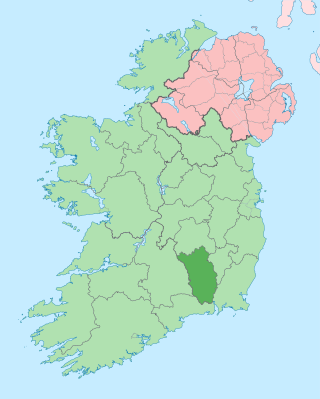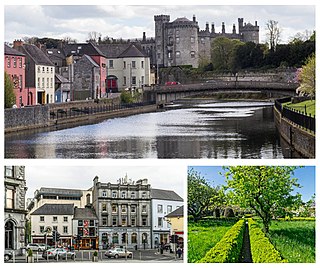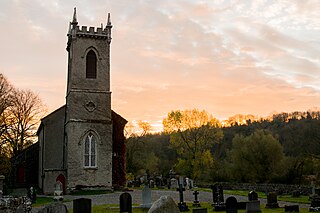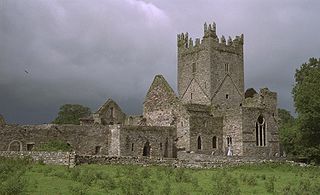
County Kilkenny is a county in Ireland. It is in the province of Leinster and is part of the Southern Region. It is named after the city of Kilkenny. Kilkenny County Council is the local authority for the county. At the 2022 census the population of the county was 103,685. The county was based on the historic Gaelic kingdom of Ossory (Osraighe), which was coterminous with the Diocese of Ossory.

Kilkenny is a city in County Kilkenny, Ireland. It is located in the South-East Region and in the province of Leinster. It is built on both banks of the River Nore. The 2016 census gave the population of Kilkenny as 26,512.

Cainnech of Aghaboe (515/16–600), also known as Saint Canice in Ireland, Saint Kenneth in Scotland, Saint Kenny and in Latin Sanctus Canicus, was an Irish abbot, monastic founder, priest and missionary during the early medieval period. Cainnech is one of the Twelve Apostles of Ireland and preached Christianity across Ireland and to the Picts in Scotland. He wrote a commentary on the Gospels, which for centuries was known as the Glas-Choinnigh or Kenneth's Lock or the Chain of Cainnech.

Saint Peter's Church, Ennisnag is a church of the United Dioceses of Cashel and Ossory and the ecclesiastical province of the United Provinces of Dublin and Cashel in the (Anglican) Church of Ireland. The church lies beside the Kings River, one mile north of Stoneyford village in County Kilkenny, Ireland. Located in the townland of Ennisnag, in the barony of Shillelogher.

Jerpoint Abbey is a ruined Cistercian abbey, founded in the second half of the 12th century in County Kilkenny, Ireland. It is located 2.5 km south west of Thomastown on the R448 regional road. There is a visitor centre with an exhibition. It has been declared a national monument and has been in the care of the Office of Public Works since 1880.

Aghaboe is a small village in County Laois, Ireland. It is located on the R434 regional road in the rural hinterland west of the town of Abbeyleix.

Rothe House is a late 16th-century merchant's townhouse complex located in the city of Kilkenny. The complex was built by John Rothe Fitz-Piers between 1594–1610 and is made up of three houses, three enclosed courtyards, and a large reconstructed garden with orchard. As a museum, it is accessible to the public.

The Diocese of Ossory is a Latin Church diocese of the Catholic Church in eastern Ireland. It is one of three suffragan dioceses in the ecclesiastical province of the Metropolitan Archbishop of Dublin. Currently, it is led by Niall Coll who was appointed on 28 October 2022 and will be ordained bishop on 22 January 2023.

The Bishop of Ossory is an episcopal title which takes its name after the ancient of Kingdom of Ossory in the Province of Leinster, Ireland. In the Roman Catholic Church it remains a separate title, but in the Church of Ireland it has been united with other bishoprics.
David Rothe was a Roman Catholic Bishop of Ossory.

St Canice's Cathedral, also known as Kilkenny Cathedral, is a cathedral of the Church of Ireland in Kilkenny city, Ireland. It is in the ecclesiastical province of Dublin. Previously the cathedral of the Diocese of Ossory, it is now one of six cathedrals in the United Dioceses of Cashel and Ossory.

The history of Kilkenny began with an early sixth-century ecclesiastical foundation, this relates to a church built in honour of St. Canice, now St. Canice's Cathedral and was a major monastic centre from at least the eighth century. The Annals of the Four Masters recorded the first reference Cill Chainnigh in 1085. Prehistoric activity has been recorded suggesting intermittent settlement activity in the area in the Mesolithic and Bronze Age. Information on the history of Kilkenny can be found from newspapers, photographs, letters, drawings, manuscripts and archaeology. Kilkenny is documented in manuscripts from the 13th century onwards and one of the most important of these is Liber Primus Kilkenniensis.
William Fitzjohn was a leading prelate in early fourteenth-century Ireland. He held the offices of Bishop of Ossory, Archbishop of Cashel, and Lord Chancellor of Ireland. He is chiefly remembered now for building the town walls of Cashel. His last years were troubled, as he quarrelled with both the English Crown and the Pope. He complained constantly about his poverty. He faced accusations, many of them clearly false, of corruption and immoral living.
The Abbey of Aghaboe is one of the most important of the abbeys and priories in County Laois. It was founded in the kingdom of Osraige by St. Canice in the 6th century. In his Vita Sancti Columbae, Adomnán refers to the abbey, saying that its name means a of the cow: "quod Latine Campulus Bovis dicitur, Scotice vero Achadh-bou"


St. Mary’s Collegiate Church Gowran, also known as the Church of the Blessed Virgin of the Assumption, is a church in the centre of the town of Gowran, County Kilkenny, Ireland. The site is a National Monument in the care of the Gowran Development Association (GDA) and the Office of Public Works (OPW). The church and its family connections have been of huge importance to Gowran and further afield over the centuries. The church is a collegiate church, which means that the priests or chaplains attached to it lived in community together. The present church was not a monastery or an abbey; however experts believe the church was built on the site of an earlier monastery. The presence of an Ogham stone on the site, which is on display in the chancel, suggests there was a place of worship here dating back 2000 years to Celtic times or beyond.

The barony of Knocktopher is a barony in the west of County Kilkenny, Ireland. The barony is 46,765 acres (189.25 km2) in size. There are 16 civil parishes made up of 125 townlands. It is one of 12 baronies in the county. The chief town is Mullinavat and it contains the settlements of Stonyford, Ballyhale, Hugginstown, Knocktopher, and Dunnamaggan. The M9 motorway bisects the barony.
Sir Richard Shee was an Irish lawyer, politician, and Deputy Lord Treasurer of Ireland. He was a prominent member of the ruling class in Kilkenny city. He is best remembered for his influence on the architecture of Kilkenny city through his founding of the Shee Alms House in Rose Inn Street, Kilkenny, and for his ornate tomb in Saint Mary's Church.

The barony of Shillelogher is a barony in the west of County Kilkenny, Ireland. The barony is 36,684 acres (148.45 km2) in size. It is one of 12 baronies in County Kilkenny. There are 19 civil parishes in Shillelogher, made up of 109 townlands. The chief town is Bennettsbridge. Shillelogher lies at the centre of the county, with the baronies of Crannagh and Kilkenny to the north (whose chief towns are Freshford and Kilkenny, and the barony of Gowran to the east. It is borders County Tipperary to the west. The N76 road bisects the barony. The river Nore flows through the barony. Danesfort Church is located in Shillelogher.

William Robertson, an Irish architect, was born in Kilkenny, Ireland, some days before 4 December 1770. He attended the Dublin Society where he was awarded with a silver medal for his drawing skills in 1795.





















